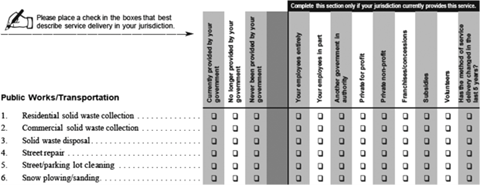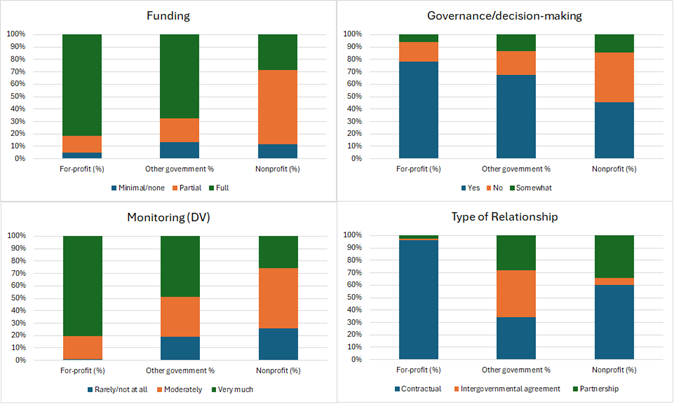
 Local services are often citizens’ most common interaction with their local government, and there are many ways that these can be provided, from in-house provision, to outsourcing to for-profit vendors or non-profit groups. Scott Lamothe and Meeyoung Lamothe write that an important survey used by researchers to better understand how local governments provide services, the International City/County Management Association’s Alternative Service Delivery survey, has data reliability issues which may affect previous analyses. They propose a redesigned survey which would give a better picture of how local governments fund services and the extent to which they are involved in governing decisions and monitoring.
Local services are often citizens’ most common interaction with their local government, and there are many ways that these can be provided, from in-house provision, to outsourcing to for-profit vendors or non-profit groups. Scott Lamothe and Meeyoung Lamothe write that an important survey used by researchers to better understand how local governments provide services, the International City/County Management Association’s Alternative Service Delivery survey, has data reliability issues which may affect previous analyses. They propose a redesigned survey which would give a better picture of how local governments fund services and the extent to which they are involved in governing decisions and monitoring.
Almost no matter where we live, we all benefit from the services provided by our local governments – from carrying services like water and electricity into our homes, to collecting our waste and maintaining our streets. Researchers who look closely at public services make the distinction between service “provision” and service “production” by local governments.
Local service “provision” and service “production”
Provision involves making such decisions as: what services the government will participate in the delivery of; the scope of services; and how those services will be paid for. Production, on the other hand, refers to how these services are delivered which can be separated from provision in pursuit of potential efficiency gains.
For example, a city may decide that it will ensure various waste collection and disposal related services are available to all citizens and will employ varying financing options to pay for them (this is provision activity). For the production and delivery of these services, the municipal government may choose from a diverse set of arrangements beyond traditional, in-house methods. This could include exclusively outsourcing curbside recycling services to a for-profit vendor, while jointly utilizing both city employees and private contractors to collect residential solid waste. Both services may be paid for through user fees. For hazardous waste, collection services might be done internally, but the disposing of such materials may be arranged through an intergovernmental partnership between the county and neighboring municipalities. In this case, financing may be shared among the governments participating in the collaboration.
It is important to note that service provision and production can be separate concepts yet closely related. For example, if a municipal government decides to not engage in full provision of a service, traditional in-house and contracting options would not be available. Rather, some other form of delivery mechanism would need to be pursued.
Data about how local services are delivered
It is, therefore, important to accurately capture the diverse nature of service provision in addition to understanding actual delivery arrangements when studying local governance. Unfortunately, the most influential dataset in this area, that has guided research for the past several decades, overlooks the former.
Since 1982, the International City/County Management Association (ICMA) has regularly collected local service delivery information in their “Profile of Local Government Service Delivery Choices” survey. This data source, colloquially known as the “Alternative Service Delivery” (or ASD) survey, was readily adopted by researchers due to its comprehensiveness (gathering information on over 60 local services), coverage (generally including responses from 1,000 to 1,500 local jurisdictions in the United States), and longitudinal nature (gathered in mostly compatible form approximately every five years from 1982 to 2017.)

Photo by Pawel Czerwinski on Unsplash
Concerns with the structure and use of the ASD data
Unfortunately, our previous research has uncovered concerns with this data source, and how it has been used by scholars, which may call into question the findings of many of the studies that have relied on this dataset (including a number of our own previous works). Many of the concerns stem from how the ASD survey is structured.
An issue with ASD survey can be seen in Figure 1 below, which shows a part of the instrument from 2002. For each service listed in the column on the left, respondents are asked to first report if the service is currently, no longer, or has never been provided by their government. If “currently provided” is marked, they are then asked to identify how the service is produced.
Figure 1 – 2002 ICMA ASD Survey Instrument Layout

The problem is that the International City/County Management Association neither defines for respondents what it means to provide a service nor allows them to elaborate on the exact nature of their provision activity (for example, do they fully pay for the service?). This can lead to reliability issues with the data as respondents, using their own judgment, often interpreting inconsistently what service provision entails. For example, two jurisdictions may both offer only small grants to nonprofit organizations to assist in their delivery of human services. The respondent of one jurisdiction may mark this a provision by the city with delivery by a non-profit. The respondent from the other may feel the government’s role is inadequate to qualify as provision by the jurisdiction and mark the “Never been provided” option. In this instance, the case would drop from analysis since no production information is subsequently collected.
Lack of service provision information from the ASD dataset invites a host of problems in local governance research. In addition to the inaccuracy of the data itself, scholars have heavily adopted principal-agent theory (where there is a conflict between the priorities of a person and those of another acting on that person’s behalf) to explain insourcing or outsourcing of local services. This, in turn, has led to the problematic assumption that all forms of external production represent standard contracting in which governments hold full principal stakes and accountability for service delivery. However, as highlighted in the example of human service nonprofits above, this can mischaracterize relationships.
Redesigning the ASD survey to better account for the nature of provision activity
In new work, we redesigned the ASD survey, especially focusing on the expansion of provision measures. Instead of merely asking whether local governments provide a service or not, we asked them to elaborate on how they fund the service as well as to what extent they are involved in governing decisions and monitoring of externally produced services.
As can be seen from Figure 2, the nature of provision activity varies considerably and appears to be systematically associated with types of delivery arrangements, suggesting that provision and production decisions are interrelated. Specifically, services outsourced to for-profit vendors seem to meet the underlying assumptions of typical principal-agent relationships – that is, governments tend to fully fund these services, are actively involved in the governance and monitoring of service producers and manage service delivery via contractual terms and conditions. Service production carried out by other governments and nonprofits differs from for-profit delivery in statistically significant ways (see our article for specific tests). It is common for local governments to only partially or minimally fund services delivered by these entities, as well as be less involved in governance and monitoring. The nature of the relationships between the governments and service deliverers is often characterized as cooperative agreements or partnerships.
Figure 2 – Service provision by producer type

Note: Total N=154
Implications for future local governance research
The potential implications of our findings could be significant. Notably, scholars should be equipped with accurate provision and production information to fundamentally re-examine the underlying conditions and motivations for insourcing and outsourcing decisions made by local governments. It is also important to explore the nature of strategies and/or challenges associated with external service production when local governments have neither full principal stakes in, nor control over, the public services which benefit their citizens.
- This article is based on the paper, ‘Towards a Better Understanding of Local Service Provision: Implications for Studying the Determinants of Production Choice’ in Public Administration Review.
- Please read our comments policy before commenting.
- Note: This article gives the views of the author, and not the position of USAPP – American Politics and Policy, nor the London School of Economics.
- Shortened URL for this post: https://bit.ly/3NZrpRs






